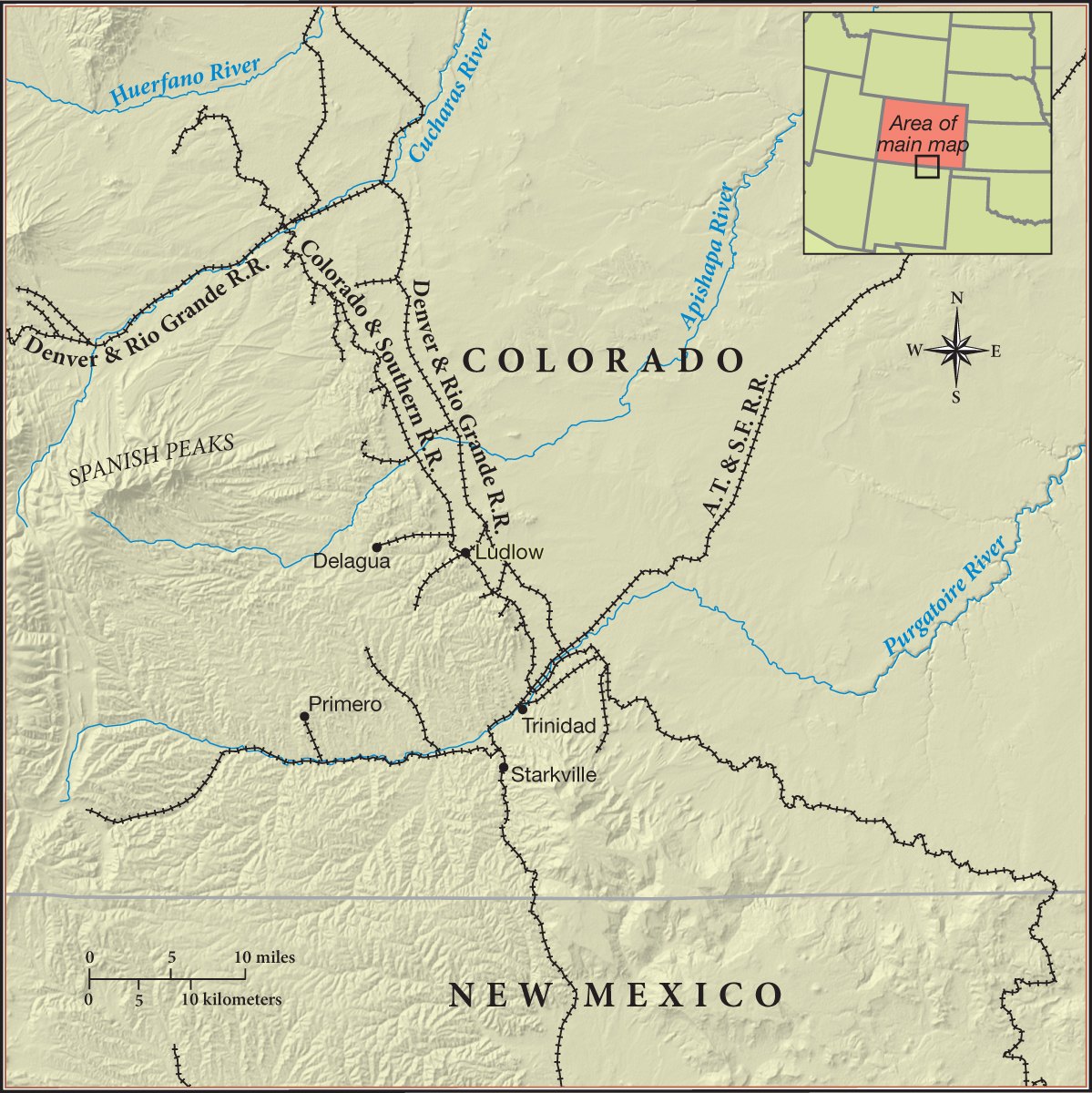Historical Background
Timeline
| 1870s | Completion of railroad lines to and within Colorado initiates industrial-scale coal mining; most early mining companies are railroad subsidiaries. |
| 1884 | First major coal-mine disaster in the American West kills 59 outside of Crested Butte, Colorado. |
| First major strike by Colorado coal miners. | |
| 1890 | Consolidation of Colorado Fuel & Iron Company, for decades the largest operator of coal mines west of the Mississippi River. |
| 1894 | Coal miners, now organized under the United Mine Workers of America (UMWA) union, again go out on strike. |
| 1903–1904 | UMWA declares another strike; again, mine operators and their allies in state and local governments defeat unionization. |
| February 1, 1910 | Primero mine disaster kills 75. |
| October 1910 | Starkville mine disaster kills 56. |
| November 1910 | Delagua mine disaster kills 79. |
| September 1913 | UMWA strikes against southern Colorado coal operators. By the time union leaders call off strike in December 1914, Ludlow Massacre (April 20, 1914) and other events result in 80 to 100 deaths, making this the deadliest labor dispute in the post–Civil War United States. |
| 1917 | Southern Colorado coal mines reach peak production; output declines thereafter, with most mines closing by 1940s. |
By the early 1900s, the United States manufactured more goods than the combined output of its three closest rivals. Coal helped to produce almost everything Americans made throughout the heady, tumultuous, and violent decades of industrial expansion between the Civil War and World War I—and almost everything they consumed, too. Burned raw or converted into electricity, compressed air, and other forms, coal drove trains and streetcars, heated stoves and furnaces, provided manufactured gas and electricity, and fueled essential technologies, including mining drills, smelters, steam shovels, and farming machinery.
In consequence, the nation’s coal-mining workforce swelled. By the 1910s, more than 750,000 men worked in and around U.S. coal mines to extract some 550 million tons of fuel. The dangers of mining, however, increased even more rapidly. Three basic factors together made U.S. mines the deadliest in the developed world. First, most coal deposits lay in huge sedimentary layers. Miners faced the daunting task, then, of trying to remove one layer of the earth without the others falling down. Workers and mining companies tried to reduce the risk of falling rock and coal in various ways, but with little success. Second, coal was highly flammable. Many coal deposits, moreover, contained large quantities of methane and other explosive gases. In the course of their work, miners introduced explosives underground; the miners’ labors also thrust huge quantities of coal dust into the mine air. Finally, mining corporations found it easy to place the pressures of production above the demands of their employees for safe work conditions—a situation facilitated by weak or nonexistent state and federal mining regulations, poor enforcement of existing mining laws, and a legal climate that almost always placed the interests of large corporations over those of working people.
Large-scale accidents caused by underground fires, flooding, or explosions of dust or methane were not uncommon, and neither were fatalities. The Avondale, Pennsylvania, disaster of 1869 killed 110 workers. A dust explosion in Monongah, West Virginia, killed 362 miners in 1907. Two years later, an underground fire at Cherry, Illinois, killed 259. The Cherry disaster was just one of the twenty disasters to afflict U.S. coal mines in 1909. Nineteen tragedies followed in 1910, including the three on which this unit focuses.
The Ill-Fated Mines of the Southern Colorado Coalfields
